
A significant labour savings potential from a most unlikely source is
among the latest buzz from the Greenhouse and Processing Crops Research
Centre in Harrow, Ontario.
Larva or caterpillar stage of European corn borer in pepper fruit.
A significant labour savings potential from a most unlikely source is among the latest buzz from the Greenhouse and Processing Crops Research Centre in Harrow, Ontario.
Bumblebees have long been workhorses in vegetable greenhouses in efficiently pollinating crops. Now, researchers are seeing how well they can serve as vectors of biological crop protection products for pest and disease management.
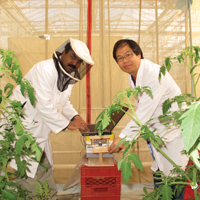 |
|
| Drs. Ghulum Mustafa and Hony-Hyun Park with a Sutton bee-vectoring dispenser.
|
“Bees are in the greenhouse pollinating anyway,” says Dr. Les Shipp. “Now we’re adding another task they can do at the same time.”
Bee vectoring is just one of dozens of projects currently underway at North America’s largest greenhouse vegetable research facility.
Other projects we recently toured include:
- A water stress study to determine its effect on fruit quality?
- Research optimal lighting strategies involving LEDs.
- A new disease prevention process that detects problems before the plants arrive for transplanting.
Long associated only with vegetable programs, GPCRC is continuing to add flower projects. One such study is looking at temperature integration strategies – which have worked so well with tomato crops – that can be applied to crops such as
chrysanthemums and poinsettias.
BUMBLEBEES ABOUT TO BECOME EVEN BUSIER
■ The phrase “busy as bees” is well demonstrated in a number of research projects under the direction of Dr. Les Shipp.
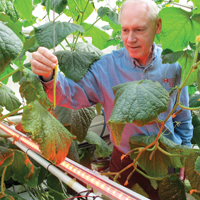 |
|
| Dr. Les Shipp is studying how LEDs affect pests and predators |
Well established in the greenhouse vegetable industry as pollinators, bees are branching out into disease and pest control distributors.
Bee vectoring studies have been carried out at Harrow for about a dozen years, and with very impressive results.
For growers, it means they won’t have to spray. “The bees are delivering the inoculum every time they go out to pollinate. It results in continuous application.”
It’s not just the flowers that get the inoculum, but also the leaves. And that’s because a bee is a buzz pollinator, shaking flowers vigorously with rapid contractions of its thorax to free up the tightly bound pollen from the flower. The microbial particles are shaken off the bee and go into the air for dispersal on the leaves as well as the flowers. Bees also groom themselves on the leaves.
One focus of the current research is with assessing the various bee vectoring dispensers being developed. The bees pick up inoculum every time they exit the hive. Working with Shipp on this study are Dr. Hong-Hyun Park, a visiting scientist from the National Academy of Agricultural Science in South Korea, and Dr. Ghulum Mustafa, a post-doc fellow who is supported in this study with funding from the Pest Management Centre of Agriculture and Agri-Food Canada.
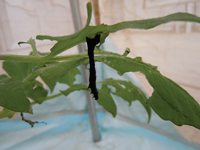 |
|
| A cabbage looper larvae that is infected with an insect baculovirus that has been delivered to tomato plants using bumblebees. PHOTO COURTESY DR. LES SHIPP, AAFC |
Several dispensers are being studied, including a unit developed by Dr. John Sutton of the University of Guelph. Sutton is a longtime bee vector researcher, along with U of Guelph colleague and Science Director of the NSERC-Canadian Pollination Initiative (CANPOLIN) Dr. Peter Kevan.
CAN THE BEES BE AFFECTED BY THE BIOCONTROLS?
■ Another project will look at whether Beauvaria bassiana, a common soilborne fungus that attacks a broad range of immature and adult insects, could affect bees if the concentration is too high or the exposure too long. “We have done work (with Beauvaria) in commercial greenhouses and have not seen any negative impact.”
Future bee vectoring studies will look at other biocontrols for disease or pest control such as viruses and bacteria for cabbage looper control. This work will be conducted in collaboration with Dr. Martin Erlandson (Saskatoon Research Centre) and Dr. Bruce Broadbent (London Research Centre).
“We have completed considerable research,” notes Shipp, adding the next step is to take what works best into commercial greenhouses. “Some growers are very eager to look at this.”
Shipp is also working with field crop applications, including a blueberry crop project with a colleague in the Maritimes, Dr. Chris Cutler at the Nova Scotia Agricultural College.
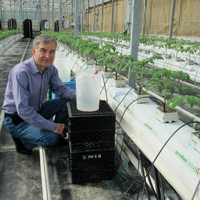 |
|
| Dr. Tom Papadopoulos: research has shown growers can expect firmer fruit if the plant is stressed for water.
|
HOW DOES SUPPLEMENTAL LIGHTING AFFECT THE BUGS?
■ Another focus of Dr. Shipp’s work is on supplemental lighting and how it will affect pests and predators. “We know insects respond differently to various wavelengths. That’s why we use yellow and blue sticky cards.”
More research – and grower interest – is being shown in supplementary lighting as a means of extending the crop season, especially for cucumbers. “If we’re going to work under lights with year-round production,” says Shipp, “you’d better know how they will affect your pests and beneficials.”
In one current project, sticky cards have been placed above the crop, near high pressure sodium (HPS) lights, and in the canopy, near different coloured light emitting diode (LED) lights (red, blue and white). This study will show what effect the lights have on pests, and especially if there are differences with the different colours of LEDs.
Another LED lighting study will look at predation rates and egg-laying capacity of predatory mites when feeding on their prey such as western flower thrips. Supplementary lighting might also lead to the return of an old favourite. Dicyphus hesperus was more popular years ago, but it would go into diapause under low light conditions. However, since it is quite effective against whitefly, it could make a comeback if used under supplemental lighting.
WATER STRESS MODELLING AND THE EFFECTS ON FRUIT QUALITY
■ What effect does water stress have on fruit quality?
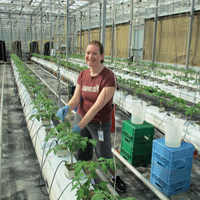
|
|
| GPCRC research assistant Celeste Little helps set up the water stress trial.
|
That’s the focus of a three-year study Dr. Tom Papadopoulos is concluding this year at the Greenhouse and Processing Crops Research Centre.
He’s working with Dr. David Ehret of the Pacific Agriculture Research Centre on a project studying different aspects of tomato fruit quality. The goal is to develop a modelling program that will allow growers to predict fruit quality depending on their production choices with respect to environmental control, nutrition and irrigation.
Research has shown growers can expect firmer fruit if the plant is stressed for water. The reason is that everything is so much more concentrated; there is less water and more dry matter. The sugar content is higher, all the flavour attributes are higher, and the fragrance is more intense.
Papadopoulos has six trials set up, ranging from low water supply to excess water supply. “We have a good range of treatments,” he explains. “We will be able to see how fruit quality varies with these treatments.”
The study will isolate small differences in fruit quality, thereby helping the researchers determine the optimal watering program. “We will be able to see how quality declines if we’re not applying the optimal water supply.”
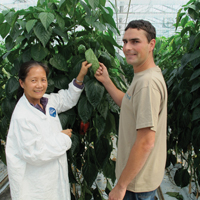 |
|
| Gillian Ferguson has been working with Del Sol Greenhouses grower Blake Fischer and greenhouse owner Dave DeLellis on a biocontrol study for ECB.
|
If water levels get too low, for example, the plant might begin wilting. If leaf stomates close to protect the plant from dessicating, the plant will no longer absorb carbon dioxide and the plant will not be as productive.
NIPPING A DISEASE THREAT AT A VERY EARLY STAGE
■ The sooner disease problems are detected in the greenhouse, the better. It doesn’t take long for a disease to spread, creating major headaches and taking up a lot of time applying crop remedies.
But what if those diseased plants were detected before they were brought into the greenhouse?
A solution might be at hand.
Dr. Ray Cerkauskas of the Greenhouse and Processing Crops Research Centre is part of a team studying whether highly sensitive thermal imaging photography can detect diseased plants at the plug stage.
The thermal imaging camera can detect temperature differences of a tenth of a degree. Are diseased portions of a leaf a different temperature than healthy tissue surrounding it, and can this be incorporated into thermal imaging photography software?
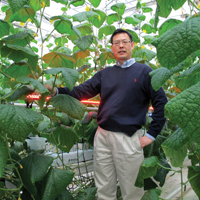 |
|
| Dr. Xiuming Hao is studying the placement of LEDs in the canopy for both light and heat.
|
The research, which is supported by the Ontario Greenhouse Vegetable Growers through a Farm Innovation Program grant, is at an early stage.
Cerkauskas is working with Dr. Roman Maev and PhD student Dmitry Gavrilov of the Department of Physics at the University of Windsor and OMAFRA greenhouse IPM specialist Gillian Ferguson on the project.
Last year, a similar study looked at identifying peppers infected with European corn borer. The problem for growers is that such peppers have no visible symptoms.
This year, the research is looking at two diseases: bacterial canker and pepino mosaic virus.
“We have seen variations in the results of inoculated plants and healthy plants,” says Cerkauskas.
Because the bacterium has a latent stage and might not show symptoms for quite a while, there’s no way of knowing you’ve got a problem unless you take a sample of a leaf for testing. “This is cumbersome and takes a long time,” notes Cerkauskas. It’s also not practical given the number of plants shipped every day. “It’s not realistic and it’s too expensive.”
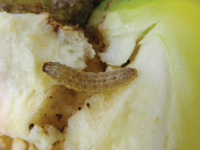 |
|
| Larva or caterpillar stage of European corn borer in pepper fruit. PHOTO COURTESY GILLIAN FERGUSON, OMAFRA |
Propagators already scan trays for uniformity, with plants found to be too large ejected with a jet of air. Adapting a thermographic camera with the right software to detect diseased plants could similarly eject problem plugs. “We’re hoping we can develop the software to pick out the diseased plant right away.”
Diseases can spread very quickly in the greenhouse. Without any symptoms, it’s easy for workers to unknowingly spread the canker or virus, “and that’s what we want to avoid,” notes Cerkauskas.
LOOKING FOR BIOCONTROL OPTION FOR ECB
■ Finding an effective biocontrol solution to suppress European corn borer is among trials being conducted by Gillian Ferguson, the greenhouse vegetable IPM (integrated pest management) specialist with the Ontario Ministry of Agriculture, Food and Rural Affairs (OMAFRA). She works out of the Greenhouse and Processing Crops Research Centre in Harrow.
Ferguson focuses on projects related to disease and pest problems of greenhouse vegetable crops, and has been a key industry resource to growers throughout the province for many years.
She collaborates on greenhouse vegetable disease projects with Dr. Ray Cerkauskas, who works at the Centre in Harrow, and also with Dr. Lorne Stobbs, who works out of Agriculture and Agri-Food Canada’s Research Centre in Vineland. Often, her projects are done in collaboration with greenhouse growers in commercial operations.
Projects that Ferguson has implemented at growers’ operations include trying to find predatory mites that are more adapted to hot, dry conditions for effective suppression of the two-spotted spider mite on greenhouse cucumbers during the summer months. Work in this area will continue, subject to availability of the experimental predatory mite species.
Another project involves looking at the effectiveness of a parasitic wasp species for managing the European corn borer (ECB) in greenhouse peppers. For these biological control projects, Ferguson has worked with Tom MacDonald of MGS Horticultural Inc., one of the major greenhouse suppliers in the Leamington area.
This year, work will continue on biological control of the European corn borer. As in 2010, it will be done in collaboration with Dave DeLellis, owner of Del Sol Greenhouses in Kingsville, and his grower, Blake Fischer. The biologicals are being supplied by MGS Horticultural Inc.
The objective of this trial is to determine whether weekly releases of the parasitic wasp Trichogramma ostriniae can be effective in suppressing European corn borer (ECB) in greenhouse peppers. This focus on ECB results from the current lack of an effective biological control agent for this pest.
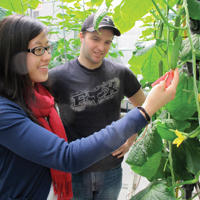 |
|
| University of Waterloo co-op students Elaine Wong and Evan Tomek check a temperature sensor in a cucumber fruit. |
LEDs WILL PLAY A ROLE IN YEAR-ROUND PRODUCTION
■ LEDs can play a significant role in year-round production of mini-cucumber crops, and it all depends on where they’re placed.
Dr. Xiuming Hao of the Greenhouse and Processing Crops Research Centre has studied year-round production of mini-cucumbers for the past few years, most recently looking at light quality issues.
He tried placing LEDs over the crop, but there was little effect on the plants.
However, overhead HPS lighting combined with intercrop LEDs (inter-lighting) seem to be a winning combination.
The LED lights not only provide the lighting boost, but they also supply heat into the canopy much like a grow pipe. Previous studies have show how effective grow pipes are in optimizing energy usage. (They’re not quite as warm: a grow pipe temperature is 50°C, while the LEDs are about 45°C.)
“The waste heat from the LED lighting system can replace the grow pipe,” says Hao, “therefore the overall energy efficiency is increased. With LEDs you not only provide lighting, but you also get overall energy efficiency because the waste heat is used in the canopy.”
“With supplemental lighting, we can increase mini-cucumber production by 200 per cent.”
Year-round mini-cucumber production is important for helping growers maintain market share. In addition, winter prices are much higher. “We have to consider the higher input costs in electricity and capital costs against the higher revenues,” Hao cautions.
TEMPERATURE INTEGRATION STRATEGIES FOR CUCUMBERS
■ In another project, Hao is developing new temperature integration strategies for cucumbers. He previously developed a similar strategy for tomatoes, which changes the growth balance to shift production earlier when prices are higher.
Overall production levels remained the same, but the fruit developed earlier. “This is good because early market prices are higher.” The new temperature integration strategy reduces energy usage per unit of produce in early fruit production.
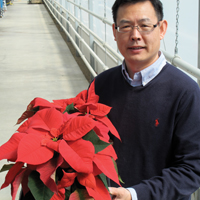 |
|
| Ornamental research is also taking place at Harrow. Dr. Xiuming Hao is part of a study looking at improved energy efficiency in growing flower crops.
|
WORKING WITH FLOWERS
■ Hao is also involved with the Ornamental Cluster administrated by the Vineland Research and Innovation Centre, and working with Drs. Mike Dixon and Youbin Zheng of the University of Guelph.
The’re looking at improved energy efficiency for growing poinsettias and chrysanthemums, major potted flower crops in Canada.
One focus will be on the development of new temperature control strategies, including temperature integration, similar to the work he has done with tomato crops. Plants can tolerate temperature fluctuations as long as the average for a given period of time remains the same. The new temperature integration strategy involves a pre-morning temperature drop when energy usage has typically been the highest. “This is the time when outside temperatures are coldest.”
He believes they can lower temperatures during this period to save energy, but only if it doesn’t compromise crop quality.
In this study, they also work on in-floor or in-bench heating since it is more efficient than air heating; in-floor or in-bench heating is more direct in transferring heat to the plant, increasing plant temperature. It is the plant temperature that determines the growth and development rates of the plants.
Growers could lower air temperatures and compensate with in-floor heating or increased rootzone temperatures. “But we have to be careful not to raise the rootzone temperature too much, or there’s a risk of damaging the roots.”
He wants to see how far you can shift the greenhouse heating to rootzone heating without hurting the crop.
With higher rootzone temperatures, the fertigation strategies may also need to be adjusted. This is another area of the research that this project is going to explore. ■
Print this page